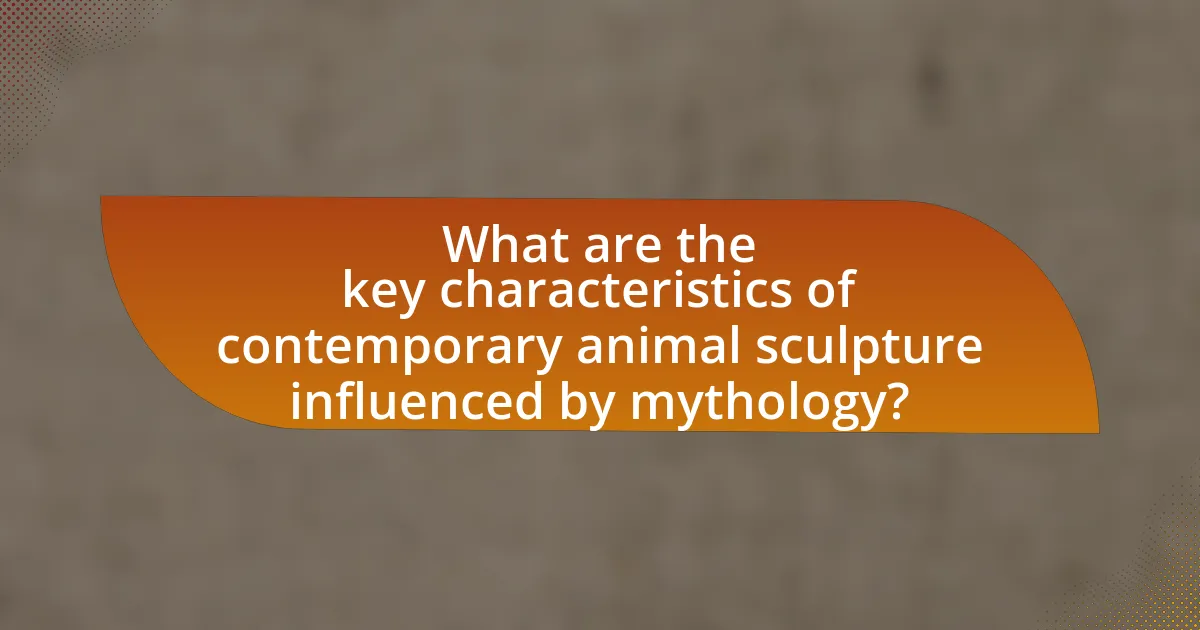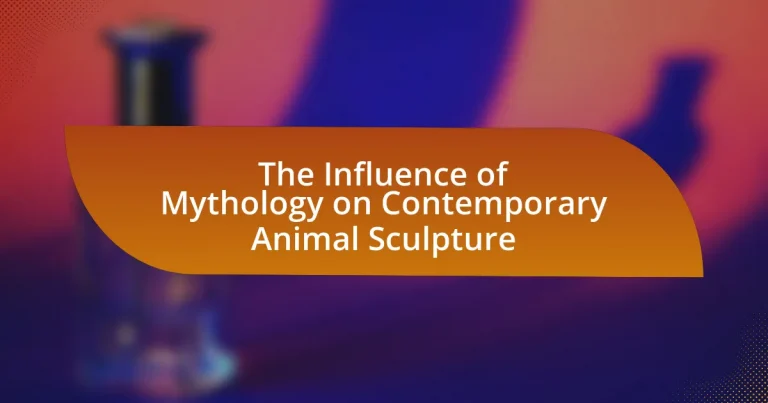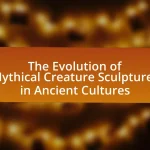The article examines the significant influence of mythology on contemporary animal sculpture, highlighting how artists utilize mythological narratives and symbols to convey deeper themes such as duality, transformation, and the relationship between humanity and nature. It discusses specific mythological stories commonly referenced in sculptures, such as the Minotaur and Ganesha, and explores how artists interpret these themes through various materials and techniques. Additionally, the article addresses the emotional impact of mythologically inspired sculptures on viewers and provides practical tips for artists to effectively blend mythology with their work. Overall, it underscores the enduring relevance of mythology in shaping contemporary artistic expression in animal sculpture.

What is the Influence of Mythology on Contemporary Animal Sculpture?
Mythology significantly influences contemporary animal sculpture by providing rich symbolic meanings and narratives that artists draw upon to convey deeper themes. Artists often incorporate mythological creatures, such as griffins or centaurs, to explore concepts of duality, transformation, and the relationship between humanity and nature. For instance, the use of animal forms in sculptures can evoke ancient myths, allowing viewers to connect with cultural stories and archetypes that resonate across time. This connection is evident in the works of contemporary sculptors like Damien Hirst, who utilizes animal imagery to comment on life, death, and the human condition, reflecting mythological themes. Thus, mythology serves as a foundational element that enriches the artistic expression and thematic depth of contemporary animal sculpture.
How has mythology shaped the themes in contemporary animal sculpture?
Mythology has significantly shaped the themes in contemporary animal sculpture by providing rich narratives and symbolic meanings that artists draw upon. Artists often reference mythological creatures, such as griffins or centaurs, to explore themes of duality, transformation, and the relationship between humans and nature. For instance, the use of animals in mythology often symbolizes various human traits or societal values, which contemporary sculptors reinterpret to comment on modern issues like environmentalism or identity. This connection is evident in the works of artists like Damien Hirst, who incorporates mythological references to provoke thought about life and death, thereby reinforcing the enduring relevance of mythology in contemporary art.
What specific mythological stories are commonly referenced in animal sculptures?
Animal sculptures commonly reference mythological stories such as the Greek tale of the Minotaur, the Egyptian representation of the Sphinx, and the Hindu narrative of Ganesha. The Minotaur, a creature with the body of a man and the head of a bull, symbolizes the duality of human nature and is often depicted in various art forms. The Sphinx, with its lion’s body and human head, represents wisdom and protection, frequently appearing in sculptures that evoke ancient Egyptian mythology. Ganesha, the elephant-headed god, embodies wisdom and the removal of obstacles, inspiring numerous sculptures in Hindu culture. These stories are integral to the sculptures, providing cultural context and deeper meaning, as evidenced by their prevalence in historical and contemporary art.
How do artists interpret mythological themes in their animal sculptures?
Artists interpret mythological themes in their animal sculptures by embodying symbolic meanings and narratives associated with specific creatures from various mythologies. For instance, a sculptor may depict a lion to represent strength and courage, drawing from its significance in numerous cultures, such as the Nemean Lion in Greek mythology. This approach allows artists to connect contemporary audiences with ancient stories, using form, texture, and scale to evoke emotions and provoke thought. The use of mythological references in animal sculptures can also serve to explore themes of transformation, duality, and the relationship between humans and nature, as seen in works that feature hybrid creatures like centaurs or griffins. Such interpretations are validated by the prevalence of these themes in art history, where mythological animals have been used to convey complex ideas and cultural values across different civilizations.
Why is mythology significant in the context of animal representation?
Mythology is significant in the context of animal representation because it provides symbolic meanings and cultural narratives that shape how animals are perceived and depicted in art. For instance, in various mythologies, animals often embody specific traits or serve as messengers of the divine, influencing their representation in sculptures. The ancient Egyptians revered cats as symbols of protection and fertility, which is reflected in their artistic portrayals. Similarly, in Greek mythology, the depiction of the eagle as a symbol of Zeus conveys power and authority, impacting contemporary interpretations of animal forms in sculpture. These mythological associations enrich the artistic representation of animals, allowing artists to convey deeper meanings and connect with cultural heritage.
What cultural values are reflected through mythological animal sculptures?
Mythological animal sculptures reflect cultural values such as spirituality, morality, and societal norms. These sculptures often embody the beliefs and ideals of a culture, serving as representations of deities, guardians, or symbols of power. For instance, in ancient Greek culture, sculptures of mythological creatures like griffins and centaurs illustrated the values of heroism and the struggle between civilization and chaos. Similarly, in Hindu culture, sculptures of animals like elephants symbolize wisdom and strength, reflecting the importance of these traits in societal values. The presence of these mythological figures in art underscores the collective identity and moral lessons that cultures aim to convey through their artistic expressions.
How does mythology enhance the emotional impact of animal sculptures?
Mythology enhances the emotional impact of animal sculptures by imbuing them with symbolic meanings and narratives that resonate with human experiences. For instance, sculptures of animals like lions or eagles often draw from mythological associations of strength, courage, and freedom, which evoke powerful emotions in viewers. Historical examples include the use of animal motifs in ancient cultures, such as the Egyptian sphinx, which combined human and animal forms to convey divine protection and wisdom, thereby deepening the viewer’s emotional connection. This interplay between mythology and sculpture allows for a richer interpretation, as the stories behind the animals amplify their significance and emotional weight.

What are the key characteristics of contemporary animal sculpture influenced by mythology?
Contemporary animal sculpture influenced by mythology is characterized by symbolic representation, intricate detailing, and a fusion of traditional and modern techniques. Artists often draw on mythological themes to convey deeper meanings, using animals as metaphors for human traits or societal issues. For instance, sculptures may depict creatures from various mythologies, such as griffins or phoenixes, to explore themes of transformation and resilience. The use of diverse materials, including metal, wood, and clay, allows for innovative textures and forms that enhance the narrative quality of the work. Additionally, contemporary artists frequently incorporate elements of abstraction, challenging viewers to interpret the mythological references in personal and contemporary contexts. This blend of tradition and innovation reflects a broader trend in art where historical narratives are reimagined to resonate with modern audiences.
How do materials and techniques reflect mythological influences?
Materials and techniques in contemporary animal sculpture reflect mythological influences through the use of symbolic materials and traditional crafting methods that evoke ancient narratives. For instance, artists often select bronze, a material historically associated with strength and immortality, to represent mythological creatures like griffins or centaurs, linking the sculpture to the enduring nature of these myths. Additionally, techniques such as carving and casting are employed to replicate the intricate details found in ancient artifacts, reinforcing the connection to mythological themes. The choice of color and texture can also mirror the attributes of mythological beings; for example, vibrant glazes may be used to depict the fantastical elements of a creature, aligning with the vivid descriptions found in mythological texts. This intentional use of materials and techniques not only honors the traditions of myth but also invites viewers to engage with the stories and meanings behind the sculptures.
What materials are commonly used in mythologically inspired animal sculptures?
Mythologically inspired animal sculptures are commonly made from materials such as bronze, stone, wood, and clay. Bronze is frequently used due to its durability and ability to capture intricate details, making it ideal for representing mythological creatures. Stone, including marble and granite, is chosen for its permanence and historical significance in classical sculpture. Wood offers a natural aesthetic and is often used in indigenous cultures to depict mythological themes. Clay is utilized for its versatility and ease of manipulation, allowing artists to create detailed representations of mythological animals. These materials not only enhance the visual appeal of the sculptures but also connect them to historical and cultural contexts, reinforcing their significance in the realm of mythology.
How do sculpting techniques vary when depicting mythological animals?
Sculpting techniques vary significantly when depicting mythological animals due to the need to convey their fantastical attributes and symbolic meanings. Artists often employ exaggerated forms, intricate details, and dynamic poses to emphasize the mythical qualities of these creatures, such as the wings of a griffin or the serpentine body of a dragon. For instance, ancient Greek sculptures of mythological beings like centaurs often utilized a combination of realistic human anatomy and stylized animal features to create a harmonious yet otherworldly representation. This approach contrasts with more contemporary techniques, where artists might integrate mixed media or digital tools to explore the mythological narrative in innovative ways. The variation in techniques reflects the cultural significance and storytelling aspects inherent in mythological representations, as seen in works from different historical periods that adapt to the artistic norms and materials available at the time.
What styles are prevalent in contemporary animal sculpture influenced by mythology?
Contemporary animal sculpture influenced by mythology predominantly features styles such as surrealism, abstraction, and realism. Surrealism often incorporates fantastical elements and dream-like qualities, reflecting mythological themes and creatures, as seen in the works of artists like Salvador Dalí. Abstraction simplifies forms and emphasizes symbolic representations of animals, allowing for a reinterpretation of mythological narratives, as exemplified by the sculptures of Henry Moore. Realism, on the other hand, focuses on lifelike representations of animals, often drawing directly from mythological stories and cultural symbolism, which can be observed in the detailed works of artists like Robert Graham. These styles collectively showcase the enduring impact of mythology on contemporary artistic expression in animal sculpture.
How do traditional styles merge with modern interpretations in these sculptures?
Traditional styles merge with modern interpretations in these sculptures through the incorporation of mythological themes and contemporary techniques. Artists often draw inspiration from ancient myths, reinterpreting them with modern materials and innovative forms, which allows for a dialogue between historical context and present-day aesthetics. For example, sculptures may utilize traditional motifs, such as animal figures from mythology, while employing modern methods like 3D printing or mixed media to create a fresh perspective. This blend not only preserves cultural heritage but also invites contemporary audiences to engage with the narratives in a new light, reflecting evolving societal values and artistic expressions.
What role does abstraction play in mythologically themed animal sculptures?
Abstraction in mythologically themed animal sculptures serves to distill complex narratives and emotions into simplified forms, allowing for deeper interpretation and engagement. This artistic approach enables sculptors to convey symbolic meanings associated with mythological creatures, such as strength, wisdom, or transformation, without the constraints of realistic representation. For instance, the use of exaggerated features or stylized forms can evoke the essence of a mythological animal, facilitating a connection between the viewer and the underlying myth. Historical examples, such as the abstract representations of griffins in ancient art, illustrate how abstraction can enhance the viewer’s understanding of cultural significance and mythological themes.

How do contemporary artists incorporate mythology into their animal sculptures?
Contemporary artists incorporate mythology into their animal sculptures by drawing on symbolic representations and narratives from various mythological traditions. For instance, artists often use animals that are significant in myths, such as the phoenix or griffin, to convey themes of transformation and power. This approach allows them to explore complex ideas about identity, nature, and the human experience. Additionally, many contemporary sculptures reinterpret mythological stories, using materials and techniques that reflect modern sensibilities while maintaining the essence of the original myths. This blending of ancient narratives with contemporary artistic practices creates a dialogue between past and present, enriching the viewer’s understanding of both the artwork and the mythology it references.
What are some notable contemporary artists known for mythological animal sculptures?
Notable contemporary artists known for mythological animal sculptures include Damien Hirst, who often incorporates themes of mythology in his works, such as his piece “The Physical Impossibility of Death in the Mind of Someone Living,” which features a shark and evokes mythological undertones. Another artist is Kiki Smith, recognized for her sculptures that blend human and animal forms, drawing inspiration from various mythologies. Additionally, artist Nick Cave creates vibrant, mythical creatures through his “Soundsuits,” which reflect cultural narratives and folklore. These artists exemplify the integration of mythological themes in contemporary sculpture, showcasing how ancient stories continue to influence modern artistic expression.
How do these artists draw inspiration from various mythologies?
Artists draw inspiration from various mythologies by incorporating symbolic elements, narratives, and archetypes into their contemporary animal sculptures. For instance, many artists reference mythological creatures such as griffins or centaurs, which serve to evoke themes of power and duality. Additionally, the use of materials and techniques can reflect cultural mythologies; for example, the incorporation of traditional methods from specific cultures can honor their mythological stories. This approach not only enriches the artwork but also connects it to historical contexts, as seen in the works of artists like Damien Hirst, who often alludes to mythological themes in his animal sculptures, thereby creating a dialogue between ancient narratives and modern interpretations.
What unique perspectives do these artists bring to mythological themes?
Artists in contemporary animal sculpture bring unique perspectives to mythological themes by reinterpreting traditional narratives through modern contexts and materials. For instance, they often blend ancient mythological symbols with contemporary issues such as environmentalism, identity, and cultural heritage. This approach not only revitalizes the relevance of myths but also invites audiences to engage with them in a new light. Specific examples include the use of recycled materials to create sculptures that reflect the fragility of nature, echoing myths that emphasize the interconnectedness of life. Such artistic choices demonstrate how these creators are not merely replicating ancient stories but are actively reshaping them to address current societal challenges.
How does the audience perceive the connection between mythology and animal sculpture?
The audience perceives a strong connection between mythology and animal sculpture, viewing animal figures as embodiments of mythological narratives and cultural symbolism. This perception is rooted in the historical use of animals in mythology, where they often represent deities, virtues, or moral lessons, as seen in ancient cultures like Greek and Egyptian civilizations. For instance, the depiction of the lion in various mythologies symbolizes strength and courage, which is frequently reflected in contemporary animal sculptures. This connection enhances the emotional and intellectual engagement of the audience, as they recognize the layered meanings behind the sculptures, linking them to broader mythological themes and stories.
What emotional responses do viewers have to mythologically inspired animal sculptures?
Viewers often experience a range of emotional responses to mythologically inspired animal sculptures, including awe, nostalgia, and curiosity. These sculptures evoke awe due to their intricate designs and the grandeur of the mythological narratives they represent, which can transport viewers to ancient cultures and stories. Nostalgia arises as these artworks connect individuals to shared cultural histories and personal memories associated with mythology. Curiosity is sparked as viewers seek to understand the symbolism and meanings behind the animal representations, prompting deeper engagement with the artwork. Research indicates that emotional responses to art are influenced by personal experiences and cultural backgrounds, reinforcing the idea that mythologically inspired sculptures resonate on multiple emotional levels.
How does cultural background influence audience interpretation of these sculptures?
Cultural background significantly influences audience interpretation of sculptures by shaping the viewer’s perceptions, values, and emotional responses. For instance, individuals from cultures with rich mythological traditions may interpret animal sculptures as representations of specific deities or cultural narratives, while those from different backgrounds might see them merely as artistic expressions. Research indicates that cultural context can alter aesthetic appreciation and meaning, as demonstrated in studies like “Cultural Differences in Art Perception” by Choi et al., which found that cultural upbringing affects how art is perceived and valued. Thus, the interpretation of sculptures is deeply intertwined with the viewer’s cultural lens, impacting their understanding and emotional engagement with the artwork.
What practical tips can artists use to effectively blend mythology with animal sculpture?
Artists can effectively blend mythology with animal sculpture by researching mythological stories and symbols related to specific animals. This foundational knowledge allows artists to incorporate meaningful elements into their sculptures, such as using the lion to represent courage in various mythologies or the owl to symbolize wisdom. Additionally, artists should consider the stylistic elements of the culture from which the mythology originates, as this can influence the form and texture of the sculpture. For example, Greek mythology often features detailed, realistic representations, while African mythology may embrace more abstract forms. Furthermore, integrating narrative elements into the sculpture, such as depicting a scene from a myth, can enhance the storytelling aspect and engage viewers more deeply. These strategies not only enrich the artistic expression but also create a connection between the sculpture and its mythological roots, making the work more resonant and impactful.


